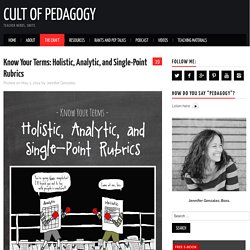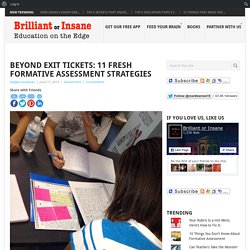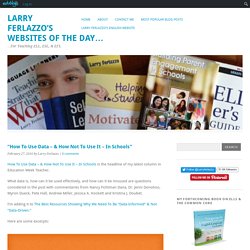

Know Your Terms: Holistic, Analytic, and Single-Point Rubrics. So let’s talk about rubrics for a few minutes.

What we’re going to do here is describe two frequently used kinds of rubrics, holistic and analytic, plus a less common one called the single-point rubric (my favorite, for the record). For each one, we’ll look at an example, explore its pros and cons, and provide a blank template you can use to create your own. Off we go! A holistic rubric is the most general kind. It lists three to five levels of performance, along with a broad description of the characteristics that define each level. Suppose you’re an unusually demanding person. When your breakfast is done, you simply gather your loved ones and say, “I’m sorry my darlings, but that breakfast was just a 2. The main advantage of a holistic rubric is that it’s easy on the teacher — in the short run, anyway.
The main disadvantage of a holistic rubric is that it doesn’t provide targeted feedback to students, which means they’re unlikely to learn much from the assignment. Sources: Mertler, C. 10 Quick-and-Easy Methods to Check for Understanding. Rethinking Data: How to Create a Holistic View of Students. The excerpt below is from “Hacking Education: 10 Quick Fixes For Every School,” by Mark Barnes and Jennifer Gonzalez.

The following is from the chapter entitled, “Hack 10: The 360 Spreadsheet.” Collect a Different Kind of Student Data For at least a decade now, the driving force behind education reform has been data. We talk about collecting data, analyzing data, and making data-driven decisions. All of this data can certainly be useful, helping us notice patterns we might not have seen without aggregating our numbers in some way, looking for gaps and dips and spikes, allowing us to figure out where we are strong and where we need help.
And yet, we know this is not enough. In the spring of 2015, Denver elementary teacher Kyle Schwartz asked her students to complete this sentence in writing: “I wish my teacher knew . . . ” The student responses were so unexpected, so moving, Schwartz shared some of them online, igniting a movement that went viral within hours. Beyond Exit Tickets: 11 Fresh Formative Assessment Strategies. Teachers who are eager to assess the development of critical content knowledge or skills during the learning experience often rely on exit tickets for quick perspective.

This affords teachers the opportunity to see what learning is happening and even to what degree at a moment when they’re able to respond most effectively. Exit tickets are powerful formative assessment tools. When every student is required to complete one by nearly every teacher they have in a given day, the practice grows a bit stale, though. Ready to mix things up a bit? Consider these approaches. Beyond the Exit Ticket: 11 Fresh Formative Assessment Strategies 1. 2. 3. 4. “How To Use Data – & How Not To Use It – In Schools” How To Use Data – & How Not To Use It – In Schools is the headline of my latest column in Education Week Teacher.

What data is, how can it be used effectively, and how can it be misused are questions considered in the post with commentaries from Nancy Fichtman Dana, Dr. Jenni Donohoo, Myron Dueck, Pete Hall, Andrew Miller, Jessica A. Hockett and Kristina J. Doubet. I’m adding it to The Best Resources Showing Why We Need To Be “Data-Informed” & Not “Data-Driven.” Here are some excerpts: Related.